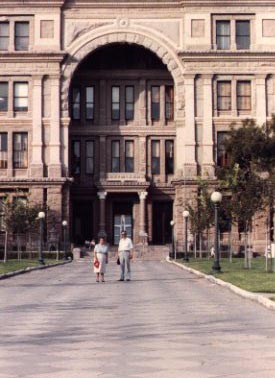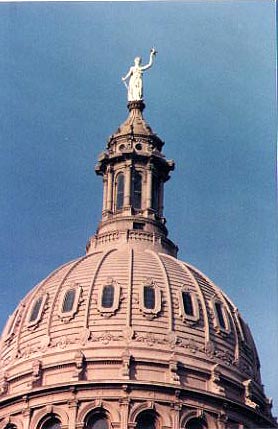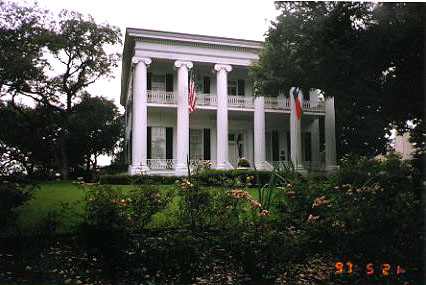English narration

capital city of Texas, located in the central part of the state. The seat of Travis County, Austin lies on the Colorado River where the river emerges from the Texas hill country and the Balcones Escarpment. Austin is the northern hub of a major economic and population region that extends southward to include the San Antonio metropolitan area. Austin houses major state and federal government offices and serves as a manufacturing, commercial, recreational, educational, and convention center.
Population:
Austin's population has increased significantly since 1980 to present, largely because of the city's economic diversification, especially into high-technology fields. According to the 1990 census, whites constitute the largest percent of Austin's population; blacks, come second; people of Asian background and Native Americans are minority. Hispanics, who may also be counted among other groups, make up the third largest group of the population.
The Austin metropolitan area also includes Williamson and Hays counties and covers 7350 sq km (2838 sq mi); notable cities included besides Austin are San Marcos and Round Rock. The metropolitan area population grew from about 500.000 in 1980 to 800,000 in the 90s. Hays County was added to the metropolitan area in 1990, accounting for much of this increase.
Economy:
For much of Austin's history, the city's economy was dominated by the state and federal government and the University of Texas. Beginning in the 1980s, the arrival of several computer technology corporations and research organizations helped diversify the economy. Since 1990 additional high-tech companies have moved to the city. Austin's other manufactured goods include food products, printed materials, furniture, and office supplies. In the early 1970s many country and western musicians moved to Austin. The city has since assumed the nickname "The Live Music Capital of the World," and each March it hosts the South by Southwest music festival, which serves as a venue for new bands of various musical styles.

The city is served by several railroads, an interstate highway, and an international airport. Austin's main daily newspaper is the Austin American-Statesman. As a state capital close to Mexico, Austin should benefit from increased international trade resulting from the North American Free Trade Agreement (NAFTA), which eliminates most tariffs and trade barriers among the United States, Mexico, and Canada.
Points of Interest:
Among Austin's points of interest are the State Capitol Building, constructed of Texas pink granite in 1888, and the Governor's Mansion (1855). Several buildings reflect Austin's early architecture, including the French Legation (1841), the residence of the French ambassador to the Republic of Texas, which existed from 1836 until 1845; the Driskill Hotel; and the Risher-Nicolas Building, which was occupied by the Austin Watchman, a black newspaper of the late 19th century and early 20th century. Natural landmarks in the region include Barton Springs, a spring-fed swimming hole that maintains a constant temperature of 20° C (68° F) and is 305 m (1000 ft) long; Mount Bonnell; and Lake Austin. The city also has an extensive park system covering a total of 5748 hectares (14,204 acres) in 1995.
Educational and Cultural Institutions:
Austin is home to the University of Texas at Austin (1883), the largest branch of the University of Texas. Other educational institutions include Huston-Tillotson College (1875), Austin Presbyterian Theological Seminary (1902), Saint Edward's University (1885), and Concordia Lutheran College (1926). Austin's cultural institutions include the Elisabet Ney Museum, once the home and workshop of the noted German-American sculptor; the home of O. Henry, which is now a museum housing many of the author's possessions; the Texas Memorial Museum; the Laguna Gloria Art Museum; the Paramount Theatre for Performing Arts; and the Lyndon Baines Johnson Library and Museum, housing papers and memorabilia of the 36th president of the United States (see Johnson, Lyndon Baines).
History:
In 1730 Franciscan missionaries established three temporary missions in the area, at sites which for centuries had been occupied periodically by groups of Native Americans. The site of the present city was settled in 1838 on the north bank of the Colorado River by five families, who named the community Waterloo. In 1839 Waterloo was chosen as the site of the permanent capital of the Republic of Texas. A one-story frame building was erected to house government offices, town lots were sold, and a newspaper began publication. In December 1839 the city was incorporated and its name was changed to Austin in honor of Stephen F. Austin, who is considered the father of Texas.

In spite of protests from the citizens of Austin, the capital was moved to Houston in 1842 because of a threatened Mexican invasion. After being located in Houston and in Washington-on-the-Brazos, the capital was returned to Austin in 1845, the year Texas became a state. Austin became the permanent capital in a state election in 1850. Despite the fact that its county voted against secession, Austin was the site of several Confederate army facilities during the American Civil War (1861-1865), and volunteers from the city organized a company of light infantry. The Houston and Texas Central Railroad reached Austin in 1871, and other railroads soon followed. The construction of a dam and power plant on the Colorado River prompted a period of industrialization between 1880 and 1900. The dam was destroyed in the flood of 1900 and was rebuilt in 1912. After major flooding in 1936, the Colorado River Authority constructed a series of dams and reservoirs on the river. This chain of reservoirs, known locally as the Highland Lakes, stretches for some 153 km (some 95 mi) inland from Austin and is a major recreation and tourist attraction for central Texas.
During World War II (1939-1945) population growth was enhanced by the establishment of several military bases in and near the city. During the decades since the war Austin has experienced unprecedented growth as the result of its economic diversification, its excellent climate, its numerous recreational and cultural opportunities, its significance as an international city, and its allure as a haven for retired people.
This site has been visited
times
|
|
| |
|
| |
|
| |
|
| |
|
| |
|
| |
|
| |